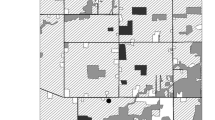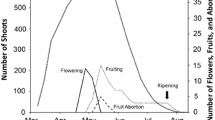Abstract
Precision of seed placement in a heterogeneous environment is often assumed to select for the evolution of animal-mediated dispersal systems, but this hypothesis has rarely been tested in a multivariate sense. We quantify the microsite fitness benefits of dispersal by white-tailed deer (Odocoileus virginianus) and raccoons (Procyon lotor) for mayapple (Podophyllum peltatum), a shade-tolerant perennial herb, in deciduous forests of southeastern Ohio, USA. Micro-environmental variables were recorded at dung-deposition microsites, at rooting points of mayapple shoots, and at random (control) points in the forest. Fitness was assessed as the degree of overlap in ordinations of microsites by environmental variables. Mayapple occupied a broad sector (56%) of environment space corresponding to low and mid-slope positions, ravines, and proximity to trees. Deer and raccoon defecation placed dung in 71–74 and 86–95% of environment space, respectively, reaching mayapple microsites in 57–60 and 53–54% of cases. Deer placed dung in mayapple environment space 7–9% more often than predicted by random distribution, and raccoons placed dung in mayapple space 0–5% more often, consistent with only a modest degree of directed dispersal. Thus, the precision hypothesis is only weakly supported. The greatest fitness benefit of vertebrate dispersal appears to be the broad distribution of seeds, thereby increasing the probability of randomly reaching a suitable microsite. Imprecise dispersal suggests that secondary mechanisms of seed movement need to be explored in deciduous forest communities.



Similar content being viewed by others
References
Baeten L, Jacquemyn H, Van Calster H, Van Beek E, Devlaeminck R, Verheyen K, Hermy M (2008) Low recruitment across life stages partly accounts for the slow colonization of forest herbs. J Ecol 97:109–117. doi:10.1111/j.1365-2745.2008.01455.x
Baldwin RA, Houston AE, Kennedy ML, Liu PS (2006) Predicting raccoon, Procyon lotor, occurrence through the use of microhabitat variables. Can Field-Nat 120:225–231
Bell G, Lechowicz MJ (1991) The ecology and genetics of fitness in forest plants I. Environmental heterogeneity measured by explant trials. J Ecol 79:663–685. doi:10.2307/2260660
Brady NC, Weil RR (2007) The nature and properties of soils, 14th edn. Prentice Hall, New Jersey
Bratton S (1976) Resource division in an understory herb community responses to temporal and microtopographic gradients. Am Nat 110:679–693
Braun EL (1950) Deciduous forests of eastern North America. The Blackburn Press, Caldwell
Celedon-Neghme C, Traveset A, Calvino-Cancela M (2013) Contrasting patterns of seed dispersal between alien mammals and native lizards in a declining plant species. Plant Ecol 214:657–667. doi:10.1007/s11258-013-0197-7
Cheptou PO, Carrue O, Rouifed S, Cantarel A (2008) Rapid evolution of seed dispersal in an urban environment in the weed Crepis sancta. Proc Natl Acad Sci 105:3796–3799. doi:10.1073/pnas.0708446105
Cohen D (1966) Optimizing reproduction in a randomly varying environment when a correlation exists between the time a choice has to be made and the subsequent outcome. J Theor Biol 16:1–14. doi:10.1016/0022-5193(66)90188-3
Connell JH (1971) On the role of natural enemies in preventing competitive exclusion in some marine animals and in rain forest trees. In: den Boer PJ, Gradwell GR (eds) Dynamics of populations. Centre for Agricultural Publishing and Documentation, Wageningen, pp 298–312
Crozier CR, Boerner RE (1984) Correlations of understory herb distribution patterns with microhabitats under different tree species in a mixed mesophytic forest. Oecologia 62:337–343. doi:10.1007/BF00384265
Cypher BL, Cypher EA (1999) Germination rates of tree seeds ingested by coyotes and raccoons. Am Midl Nat 142:71–76. doi:10.1674/0003-0031(1999)142[0071:GROTSI]2.0.CO;2
Division of Geological Survey (1998) Physiographic regions of Ohio. http://www.dnr.state.oh.us/Portals/10/pdf/physio.pdf [Accessed 7 June 2010]
Eriksson O (2002) Ontogenetic niche shifts and their implications for recruitment in three clonal Vaccinium shrubs: Vaccinium myrtillus, Vaccinium vitis-idaea, and Vaccinium oxycoccos. Can J Bot 806:635–641. doi:10.1139/b02-044
Etchberger RC, Mazaika R, Bowyer RT (1988) White-tailed deer, Odocoileus virginianus, fecal groups relative to vegetation biomass and quality in Maine. Can Field-Nat 102:671–674
Gadgil M (1971) Dispersal, population consequences and evolution. Ecology 52:253–261. doi:10.2307/1934583
García D, Obeso JR, Martínez I (2005) Spatial concordance between seed rain and seedling establishment in bird-dispersed trees: does scale matter? J Ecol 93:693–704. doi:10.1111/j.1365-2745.2005.01004.x
Geber MA, De Kroon H, Watson MA (1997) Organ preformation in mayapple as a mechanism for historical effects on demography. J Ecol 85:211–223. doi:10.2307/2960652
Ghert SD (2003) Raccoon Procyon lotor and allies. In: Feldhamer GA, Thompson BC, Chapman JA (eds) Wild mammals of North America, biology, management, and conservation. Johns Hopkins University Press, Baltimore, pp 634–661
Giladi I (2006) Choosing benefits or partners, a review of the evidence for the evolution of myrmecochory. Oikos 112:481–492. doi:10.1111/j.0030-1299.2006.14258.x
Gros A, Joachim Poethke H, Hovestadt T (2006) Evolution of local adaptations in dispersal strategies. Oikos 114:544–552. doi:10.1111/j.2006.0030-1299.14909.x
Harrelson SM, Matlack GR (2006) Influence of stand age and physical environment on the herb composition of second-growth forest, Strouds run, Ohio, USA. J Biogeogr 33:1139–1149. doi:10.1111/j.1365-2699.2006.01489.x
Herrera CM (2002) Seed dispersal by vertebrates. In: Herrera CM, Pellmyr O (eds) Plant–animal interactions an evolutionary approach. Blackwell Science, Oxford, pp 185–208
Hooten MB (2001) Modelling the distribution of ground flora on large spatial domains in the Missouri Ozarks. MSc Thesis, University of Missouri, Columbia
Howe HF, Smallwood J (1982) Ecology of seed dispersal. Annu Rev Ecol Syst 13:201–228. doi:10.1146/annurev.es.13.110182.001221
Janzen DH (1970) Herbivores and the number of tree species in tropical forests. Am Nat 104:501–528. doi:10.1086/282687
Jaroszewicz B, Pirożnikow E, Sondej I (2013) Endozoochory by the guild of ungulates in Europe’s primeval forest. For Ecol Manag 305:21–28. doi:10.1016/j.foreco.2013.05.004
Jordano P, Garcia C, Godoy JA, Garcia-Castano JL (2007) Differential contribution of frugivores to complex seed dispersal patterns. Proc Natl Acad Sci USA 104:3278–3282. doi:10.1073/pnas.0606793104
Kolb A, Barsch K (2010) Environmental factors and seed abundance influence seedling emergence of a perennial forest herb. Acta Oecol 36:507–513. doi:10.1016/j.actao.2010.07.003
Kollmann J (2000) Dispersal of fleshy-fruited species, a matter of spatial scale? Perspect Plant Ecol Evol Syst 3:29–51. doi:10.1078/1433-8319-00003
Krochmal A, Wilkins L, Van Lear D, Chien M (1974) Mayapple (Podophyllum peltatum L.) USDA Forest Service, Research Paper NE-296, Northeastern Forest Experiment Station
Landa K, Benner B, Watson MA, Gartner J (1992) Physiological integration for carbon in mayapple Podophyllum peltatum, a clonal perennial herb. Oikos 63:348–356. doi:10.2307/3544960
Lechowicz MJ, Bell G (1991) The Ecology and genetics of fitness in forest plants II microspatial heterogeneity of the edaphic environment. J Ecol 79:687–696. doi:10.2307/2260661
LoGiudice K, Ostfeld RS (2002) Interactions between mammals and trees, predation on mammal-dispersed seeds and the effect of ambient food. Oecologia 130:420–425. doi:10.1007/s004420100810
Malo JE, Suarez F (1998) The dispersal of a dry-fruited shrub by red deer in a Mediterranean ecosystem. Ecography 21:204–211. doi:10.1111/j.1600-0587.1998.tb00673.x
Martin AC, Zim HS, Nelson AL (1961) American wildlife & plants a guide to wildlife food habits. Dover Publications, New York
Massé A, Côté SD (2009) Habitat selection of a large herbivore at high density and without predation, trade-off between forage and cover? J Mammal 90:961–970. doi:10.1644/08-MAMM-A-148.1
Matlack GR (1987) Diaspore size, shape, and fall behavior in wind dispersed plant species. Am J Bot 74:1150–1160. doi:10.2307/2444151
Matlack GR (1993) Microclimate variation within and among forest edge sites in the eastern US. Biol Conserv 66:185–194. doi:10.1016/0006-3207(93)90004-K
Matlack GR (1994) Plant species migration in a mixed-history forest landscape in eastern North America. Ecology 75:1491–1502. doi:10.2307/1937472
Mayberry R, Elle E (2009) Effects of forest structure and microhabitat on the distribution and flowering of a rare understory plant, Actaea elata. For Ecol Manag 258:1102–1109. doi:10.1016/j.foreco.2009.05.042
Myers JA, Vellend M, Gardescu S, Marks PL (2004) Seed dispersal by white-tailed deer, implications for long-distance dispersal, invasion, and migration of plants in eastern North America. Oecologia 139:35–44. doi:10.1007/s00442-003-1474-2
Nathan R, Muller-Landau HC (2000) Spatial patterns of seed dispersal, their determinants and consequences for recruitment. Trends Ecol Evol 15:278–285. doi:10.1016/S0169-5347(00)01874-7
Neubert MG, Caswell H (2000) Demography and dispersal: calculation and sensitivity analysis of invasion speed for structured populations. Ecology 81:1613–1628. doi:10.2307/177311
Niederhauser EC, Matlack GR (2015) All frugivores are not equal: exploitation competition determines seed survival and germination in a fleshy-fruited forest herb. Plant Ecol 216:1203–1211. doi:10.1007/s11258-015-0494-4
Nixon CM, McClain MW, Russell KR (1970) Deer food habits and range characteristics in Ohio. J Wildl Manag 34:870–886. doi:10.2307/3799156
Olivero AM, Hix DM (1998) Influence of aspect and stand age on ground flora of southeastern Ohio forest ecosystems. Plant Ecol 139:177–187. doi:10.1023/A:1009758501201
Page LK, Swihart RK, Kazacos KR (1998) Raccoon latrine structure and its potential role in transmission of Baylisascaris procyonis to vertebrates. Am Midl Nat 140:180–185
Platt WJ, Weis IM (1977) Resource partitioning and competition within a guild of fugitive prairie plants. Am Nat 111:479–513. doi:10.1086/283180
R Core Team (2013) R, A language and environment for statistical computing, Vienna Austria, R Foundation for Statistical Computing. Available at, http://www.R-project.org
Reid N (1989) Dispersal of mistletoes by honeyeaters and flowerpeckers, components of seed dispersal quality. Ecology 70:137–145. doi:10.2307/1938420
Rey PJ, Alcantara JM (2000) Recruitment dynamics of a fleshy-fruited plant Olea europaea: connecting patterns of seed dispersal to seedling establishment. J Ecol 88:622–633. doi:10.1046/j.1365-2745.2000.00472.x
Russo SE, Portnoy S, Augspurger CK (2006) Incorporating animal behavior into seed dispersal models, implications for seed shadows. Ecology 87:3160–3174
Rust RW, Roth RR (1981) Seed production and seedling establishment in the mayapple Podophyllum peltatum L. Am Midl Nat 105:51. doi:10.2307/2425009
Sargent S (1995) Seed fate in a tropical mistletoe, the importance of host twig size. Funct Ecol 9:197–204. doi:10.2307/2390565
Schneider R, Sharitz R (1988) Hydrochory and regeneration in a bald cypress-water tupelo swamp forest. Ecology 69:1055–1063. doi:10.2307/1941261
Schupp EW, Fuentes M (1995) Spatial patterns of seed dispersal and the unification of plant population ecology. EcoScience 2:267–275. doi:10.1080/11956860.1995.11682293
Schupp EW, Jordano P, Gomez JM (2010) Seed dispersal effectiveness revisited: a conceptual review. New Phytol 188:333–353. doi:10.1111/j.1469-8137.2010.03402.x
Sohn J, Policansky D (1977) The costs of reproduction in the mayapple Podophyllum peltatum berberidaceae. Ecology 58:1366–1374. doi:10.2307/1935088
Spiegel O, Nathan R (2010) Incorporating density dependence into the directed-dispersal hypothesis. Ecology 91:1538–1548
Strobl C, Malley J, Tutz G (2009) An introduction to recursive partitioning, rationale, application and characteristics of classification and regression trees, bagging and random forests. Psychol Methods 14:323–348. doi:10.1037/a0016973
Tajchman SJ, Lacey CJ (1986) Bioclimatic factors in forest site potential. For Ecol Manag 14:211–218. doi:10.1016/0378-1127(86)90119-2
QGIS Development Team (2012) QGIS geographic information system, Open Source Geospatial Foundation. http://qgis.osgeo.org. Accessed May 2012
Vakili K, Schmitt E (2014) Finding multivariate outliers with fastPCS. Comput Stat Data Anal 69:54–66. doi:10.1016/j.csda.2013.07.021
Venable D, Brown J (1993) The population-dynamic functions of seed dispersal. Plant Ecol 107:31–55. doi:10.1007/BF00052210
Verheyen K, Hermy M (2004) Recruitment and growth of herb-layer species with different colonizing capacities in ancient and recent forests. J Veg Sci 15:125–134. doi:10.1111/j.1654-1103.2004.tb02245.x
Walter WD, Ver Cauteren JC, Campa H, Clark WR, Fisher JW (2009) Regional assessment on influence of landscape configuration and connectivity on range size of white-tailed deer. Landsc Ecol 24:1405–1420. doi:10.1007/s10980-009-9374-4
Wenny DG (2001) Advantages of seed dispersal, a re-evaluation of directed dispersal. Evol Ecol Res 3:51–74
Wenny DG, Levey JG (1998) Directed seed dispersal by bellbirds in a tropical cloud forest. Proc Natl Acad Sci 95:6204–6207. doi:10.1073/pnas.95.11.6204
Westoby M, Leishman M, Lord J, Poorter H, Schoen DJ (1996) Comparative ecology of seed size and dispersal. Philos Trans R Soc Lond B Biol Sci 351:1309–1318. doi:10.1098/rstb.1996.0114
Whigham DF (2004) Ecology of woodland herbs in temperate deciduous forests. Annu Rev Ecol Syst 35:583–621. doi:10.1098/rstb.1996.0114
Williams SC, Ward JS, Ramakrishnan U (2008) Endozoochory by white-tailed deer Odocoileus virginianus across a suburban/woodland interface. For Ecol Manag 255:940–947. doi:10.1016/j.foreco.2007.10.003
Willson MF, Traveset A (2000) The ecology of seed dispersal. In: Fenner M (ed) Seeds, the ecology of regeneration in plant communities. CABI Publications, Boston, pp 85–110
Zheljazkov VD, Jones AM, Avula B, Maddox V, Rowe DE (2009) Lignan and nutrient concentrations in American mayapple Podophyllum peltatum L in the eastern US. HortScience 44:349–353
Acknowledgements
We are grateful for a Grant in Support of Research to E.C.N. from the Ohio University Graduate Student Senate. Two anonymous reviewers made helpful comments on the manuscript. Thank you!
Author information
Authors and Affiliations
Corresponding author
Ethics declarations
ECN and GRM conceived and designed the study. ECN did the fieldwork and analysis. ECN and GRM jointly prepared the manuscript.
Additional information
Communicated by John Thomas Lill.
Rights and permissions
About this article
Cite this article
Niederhauser, E.C., Matlack, G.R. Do deer and raccoons defecate in the right place? Fitness consequences of vertebrate seed dispersal for a deciduous forest herb. Oecologia 183, 727–737 (2017). https://doi.org/10.1007/s00442-016-3803-2
Received:
Accepted:
Published:
Issue Date:
DOI: https://doi.org/10.1007/s00442-016-3803-2




